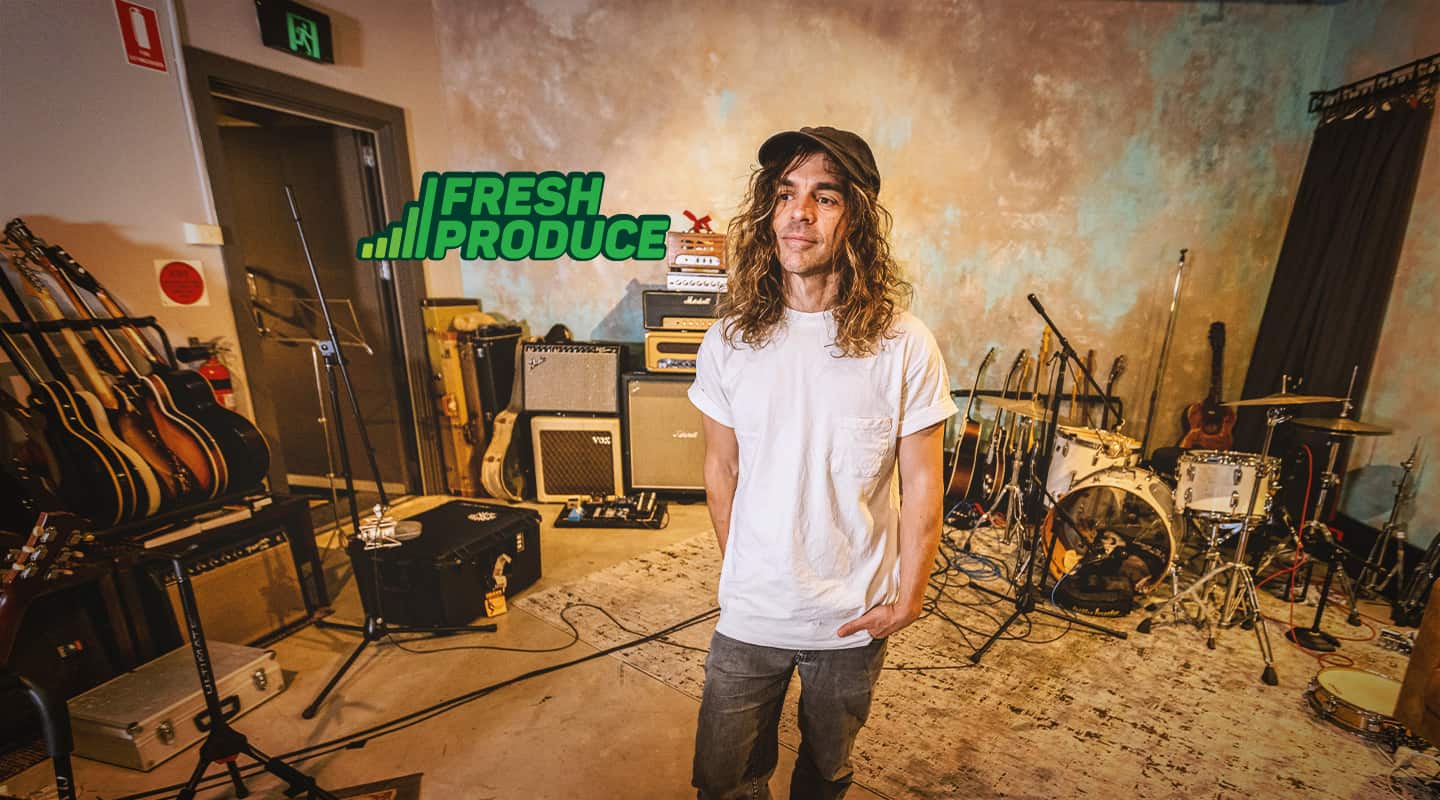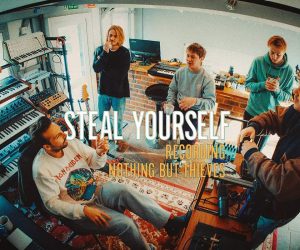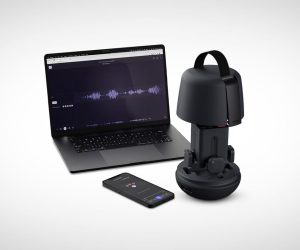
Fresh Produce: Nathan Cavaleri
A bolt from the blues: The disciplines of self-discipline and self-producing.
Gig-ready from a young age, gifted guitarist Nathan Cavaleri became a household name through his regular appearances on ‘Hey Hey It’s Saturday’ in the early 1990s. Across the next decade he performed with blues and rock royalty — sharing stages with B.B. King, Mark Knopfler, Etta James, Bonnie Rait, as well as signing to Michael Jackson’s ‘MJJ Music’ label. As he was snapped up by artists and studios globally, the blues-rock child-prodigy’s career was becoming set in stone.
Understandably, that kind of legacy can weigh heavily on someone, and over the subsequent decades he felt an obligation to honour his career and the music it was founded on. In time this became creatively inhibitive and increasingly unmanageable, and left him needing to step away from music altogether. The well publicised breakdown hasn’t defined him, but the way he emerged from it has.
Nathan’s first ‘mature age’ solo release, the 2020 album ‘Demons’, takes the first deliberate steps away from the focus of his highly-visible youth, and begins a skin-shedding process. “I developed these social anxieties — all sorts of crippling habits that made my world really small. But when I started to learn about myself I started to realise how much of it was just in my head, and I needed to challenge that,” Nathan said. “I developed tools to be able to work with those thoughts and emotions, and that’s what got me inspired.”
Facing these anxieties also meant being able to break the mould, which allowed for a redefining of his talents and musical pursuits. He continued, “I began overcoming the social anxieties and getting back out in the world again — reclaiming those joys — and I thought to myself, ‘I wonder if it’s the same with music as well’. I didn’t want to turn my back on something I’d worked my whole life for, just out of fear.” Where ‘Demons’ was a vessel for rediscovery, his new album ‘Miracles’ seems to deliver rebirth and reinvention.
GOLDEN EARS FOR THE SILVER SCREEN
Nathan dove headfirst into self-producing the new album, which was released in June this year, and while he has no formal training in audio engineering, the album certainly doesn’t suggest it. That’d be thanks to the autodidactic relationship that Nathan has had with audio and music throughout his life. He’s tinkered with tape decks and four-tracks from the age of eight, and was able to glean a broader understanding of production during studio sessions throughout his youth.
Further to this, he has also had an internationally celebrated career in composition for screen and television since 2006. “I’ve been working at Song Zu as a screen composer for over 15 years, and I never expected I’d learn so much from being a screen composer — even the TVCs I’ve worked on as my bread and butter have benefitted my production and songwriting skills,” he shares. But initially it wasn’t as clear-cut as all of that. “I suppose the challenge was in going between the two sides of the brain, and that’s sometimes what trips me up. To be honest, I had a lot of insecurities and doubts about whether I could produce this album — let alone mix it.”
With regard to the previous album, he explains, “People I worked with would ask, ‘Dude, why are you not doing this yourself?’ And I realised that it’s because I’ve had doubts around my ability to see things objectively, and so I wasn’t able to get outside of myself as an artist. I needed to let go of the things I’d been holding onto in order to make the album the best it can be.”
The decision to go it alone was actually thanks, in part, to some advice given by mix engineer maestro, Andrew Scheps, following a chance meeting on a cruise on Lake Macquarie in 2020. They struck up a friendship on the boat when it was discovered they’d both been slated to work on the cancelled 1995 TV special, ‘Michael Jackson: One Night Only’ — where Andrew was doing sound and Nathan was set to perform.

SOUND ADVICE SOUNDS GOOD
Andrew Sheps became a mentor, and offered his advice and feedback over Zoom calls and chats. While Nathan was caught in a moment of analysis-paralysis, he offered a helpful perspective — a kind of mantra, if you will — to help remove some of that doubt. Nathan says, “I was the kind of person who’d worry that if I was needing to, say, boost 5kHz by more than 4-5dB, then there must be a problem with my mix. But Andrew told me, ‘If you’ve got to boost it all the way up, like, whatever… If it sounds good, it sounds good!”
News flash: it sounds good. From stylistic- and production-based standpoints ‘Miracles’ covers an impressive amount of ground. Opening with some sure-footed coastal/dolewave swagger, the album winds it way effortlessly through classic rock, yacht-rock, and delta/southern blues — and perhaps there’s even a nod to Dennis Waterman’s bawdy ‘Minder Theme’ too.
All of this genre-hopping is supported by convincing production elements that seem simultaneously able to accentuate the differences, while cohesively tying it all back together again. As far as common factors or devices go, the album feels cohesively bound by a variety of elements. Nathan shares, “I did start to form little patterns around how I was going to create things. The drums took some experimenting, but the fundamental drum sounds across a lot of the tracks are quite similar. Then throughout the mix process they really began to sit in different worlds.”
FAST TWITCH MIXES
As a source of productivity it seems rather counterintuitive, but another interesting motivational tool has seen Nathan taking to Twitch to live stream his studio sessions. “The first couple of months were hard because I was still in ‘performance mode’, and focussed on the audience. This was pulling me away from creating, but eventually I sank into it,” Nathan shared.
Much like having a client in the studio, relying on you to turn up on time and get work done, Nathan shares that, “Going live on Twitch ended up creating an incredible focus because I knew I had to commit.” He continues, “If I was ever feeling a bit unmotivated or distracted, like, ‘Oh, I think I want to go for a walk, or check my emails’ or whatever, I’d know that they were expecting me to be online and mixing,” he said. “It’s just having another presence in there with you, with expectations, you know?”
This novel approach to motivation was also found to be creatively beneficial in that it that helped him to push through a fear of judgement. “I actually learnt a lot from the chat. I learnt how to better handle my insecurities because when somebody was being an arse and it bothered me, I could pause and think, ‘Oh, I’ve got that belief in there that I should probably work on’.”
Nathan found that the live chat also allowed him to make quicker decisions because some of his audience were offering him valuable suggestions and constructive criticism. “Every now and then I’d have somebody make a comment. They’d make suggestions that informed me that they knew what they were on about — you don’t make those kinds suggestions unless you’re a big-dog. And they wouldn’t say who they were either, they’d just comment and piss off, and I’d never hear from them again.”
When preparing himself for the project, Nathan had a clear vision of how he needed to approach the mix, stating that, “You can mix creatively, or you can mix from a place of fear. With my insecurities I had a tendency to default to mixing with fear. When you mix from this place you can end up with really safe, boring mixes.”
GO WITH THE FLOW
So, what does Nathan Cavaleri’s workflow look like? Is he a hardware-tragic, or does he prefer the convenience and immediacy of working ’in the box’? Well, a bit of A, a bit of B. Naturally, growing up in the 90s — in studios, on big-label budgets — he was well acquainted with high-end analogue studios. “As you know, I grew up on blues,” he says. “I’m a purist — I love hardware and amps, and I was probably a snob for a long time when it came to guitars, amps and simulators. This is the first album that I’ve actually used a lot of software amps.”
Nathan explains that, “Compared to the previous album, the main thing about this one is that it had to be about capturing the energy of the moment, and I so wanted to remove any blocks that got in the way. Perfectionism is a real thing, and obviously this is a distraction. So when I have to use an amp and I have to get that sound I generally find that I fall short — there’s something that pisses me off about it, so I’m never happy.”
He felt that having the option to re-amp between the production and mix process would give him more flexibility, but quickly realised that it was an option that could also smother his creative flow. “I got to the point where I’d be about to re-amp and realised that there were a lot of tracks on there and started to think, ‘Why? Why would I bother when this already sounds great?!’ The only reason why I would have tried to amp it up was the worry that maybe it could sound better. But then I thought, ‘I’m not going to do that to myself’. I did that last time and really struggled with needing to over-process things, then finding they’d lost their energy.”
He continues, “So as part of my process this time, I recorded in the box because I didn’t want to mix those two parts of the brain — engineering and performance.” As Nathan adjusts to this shift away from hardware he says, “I always feared having to confess it, to be honest, because I can imagine all my peers thinking, ‘Ohh, that doesn’t sound like a real amp’. And that’s why I won’t get specific on which songs because I don’t want to skew the experience for people.”
As far as plugins go, Nathan lists a few of the favourites he used on the album. “I heavily relied on Waves ‘Scheps Omni Channel’. That thing is just great. Really tasteful, and I love that low-mid cabinet-type sound it has. Then there’s Newfangled Audio’s Elevate suite. The Saturator is just so good, I like to use that on a mastering or drum buss.
“As far as the guitar side of things, I’d have to say Helix Native. I was using this for a lot of different things, but mainly for the delays and mods. I’ve also been going through a massive psychedelic verb-y phase and I have two favourite verbs. There’s the Spring Reverb in Guitar Rig, which is killer. It just sits in the mix beautifully. Then, like everybody else, there’s the Valhalla VintageVerb. I feel like this is going to be one of those reverbs that you look back and think, ‘Oh, that was such a 2020s sound’, because it’s on everything.”


ON STUDIO TIME
Most of the recording and mixing phase of the album took place in his suite at Massive Music (formerly Song Zu), and having worked there for 15 years, it was a space that Nathan had become more than familiar with. “That was the first professional room I’d had to engineer and create my own stuff in, and to me that was a ‘live’ room,” he shared. In the suite Nathan ran Protools with his UA Apollo interface, the studio’s rack of 4110 preamps and Neve 1073OPX, as well as his own 1176 compressor and Vintech X73 pre.
But after building his new studio he was surprised by how he was now capturing sounds that required less post-processing than before, and went on to say, “To be honest, I always thought that it was just me — all the work that I’d normally have to do just to pull a drum sound and get it sounding how I wanted. But then I moved here and realised that it was the room!”
The new studio space was designed by Rick O’Neill and is still a work in progress, but that suits Nathan just fine. “I’m not a massive gear-head, I just make do with what I’ve got. In my first rig I just had an SM58, and so that got me learning how to use ‘space’ in general. I was always fascinated by what you can do with just one mic. Then I got a second mic, another 58. So I built things up slowly, and along the way I just learnt how to be as purposeful as possible. And I feel like that’s never left me.”
Nathan continued, “I grew up on the schooling that you don’t have to have the best gear in the world to create something that moves people. This got me really focussed on what actually matters when you’re creating a song, and what really matters when you’re producing — the songwriting process obviously, and then the mix itself.”

GEAR NO EVIL
Even though Nathan has adopted many facets of software-based recording, there is still some hardware in the studio that he can’t do without. In pole position, the Shure SM7 features prominently on the album and was used widely on snare and hats, as well as doubling as a vocal mic. This is also the mic used in his Twitch broadcasts.
While the Shure was generally Nathan’s go-to he also had a handful of other microphones at his disposal — including some clones built in Melbourne by Open Plan Recording. He would sometimes track vocals with a Sennheiser MD 441, but the O.P.R 251 — a clone of Telefunken’s ELA M 251 — was chosen when he wanted to capture his voice in a more open, polished way.
O.P.R’s Rocket, a Coles 4038 ribbon mic clone, was used on overheads and room mic’ing, however a pair of Neumann M149s were also given room mic duties too. While the SM7 was generally favoured on snares Nathan would occasionally swap in a Sennheiser MD 421 there as well — so all in all, quite a range of different flavours on hand.
Nathan has some plans for outboard gear too: “There was an old Chandler preamp that I was running my SM7 into at a studio I was working at and just loved the sound of it”, but after discovering the asking price thought, ‘I need one of those for my studio, but ohh — maybe after a few hit albums I’ll be able to buy one’.” And his preferred guitar/amp combo? “That would have to be a Fender Telecaster with a PAF up the front, single coil in the back, with my old Fender Princeton. Although maybe not mine. I always get the shits that mine doesn’t have reverb.”
Defying discomfort and analysis-paralysis thanks to a healthy dose of self-reflection, Nathan has ridden a continuation of growth between ‘Demons’ and ‘Miracles’. Comfortably grounded in genres outside the wheelhouse usually associated with his name, he’s managed to create an album that feels like an awakening and a rebirth.
Nathan concludes by saying, “Even with the internal and external doubts associated with making an album that’s not rooted in traditional blues, the overall theme has always been about doing what aligns with my truth. Since my late teens I just wanted to be able to create songs with my guitar that moved people, so that was the aim throughout this whole process — create an album that does something to me, and if it makes others feel something too, then that’s a bonus. And if they get inspired, then it’s done its job.”
In a distinct, coherent fashion the variety of song-writing and production chops on ‘Miracles’ prove that blues isn’t the only string to Nathan’s guitar.



























RESPONSES